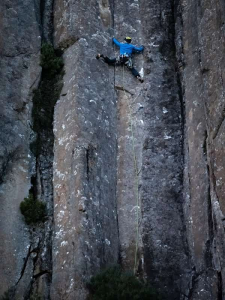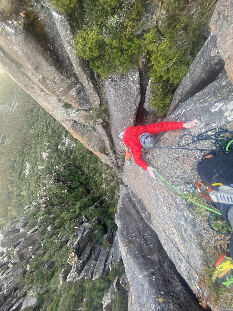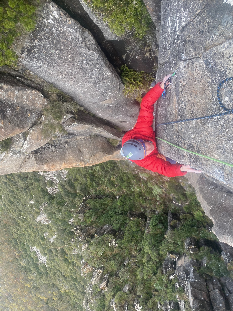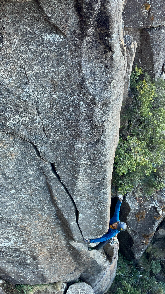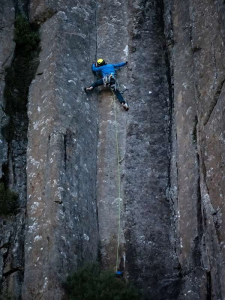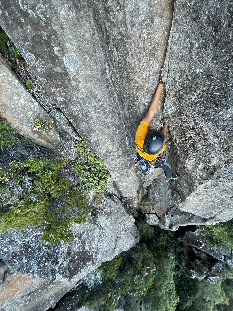- CCT Public Page
- [CCT Members Area]
Guide hosted and printed by
We used to do this all the time, and it's probably considered cheugy these days, but sorry I can't help myself posting these ones as I'm so excited that such great trad lines can still be found on the pipes these days!
- Check out Upper reaches buttress found autumn 2025 - a un-touched buttress with quick access, and 4 new trad lines up 45m high, including the unique-for-the pipes Wild Thing 22 by Jamie Spencer, that was confirmed *** on repeat ascents. See Jamie Spencer's photos of Az in blue then orange during an early repeat.
- The Nightingale *25 35m was rejected by Lord Hartshorne due to a contrived section up high, but still climbs really well and we don't have many other sections of trad this hard on the pipes. Photos tx to Michael Lehmann of HJ stemming double cracks.
- Max Rockatansk 26 65m has an alternative possibly improved start as a project (HJ), but as it stands is a remarkably good (***) 2 pitch, all-trad weaving thin crack plus slappy arete. Photos show Jem topping out. On first attempt a while back there were too many pebbles rattling around/blocking the thin crack, but now cleaed this is a total gem.
Heads up... there is a Bassian Thrush reportedly nesting at the base of route 'Living the Dream' below Battle Cruiser Ledge. Apparently it is a bit distressed by the presence of climbers. Please stay away from these small collection of climbs for another month. Climbs on Battle Cruiser Ledge should be fine.
Bassian Thrush: https://www.birdsinbackyards.net/species/Zoothera-lunulata
https://australian.museum/learn/animals/birds/bassian-thrush/
Peter Jackson 21/10/1943 to 10/10/2025 obituary.
Peter Jackson has died
after a long illness that he endured for the last 12 years of his life and subdued his otherwise prodigious productivity in Australian climbing culture.
Peter is survived by wife, daughter and two sons and a handful of his climbing partners who continue to gain inspiration from his memory. Peter lived a multifaceted climbing life that is hard to summarize, with the breadth of his influence spanning beyond even that already celebrated in the numerous articles written about his career.
Peter’s pioneering of new crags and climbs started in the 1960s ‘golden era’ of Victorian climbing, and continued throughout the 70s, 80s and 90s in Tasmania. He carried a vision that
was infectious, which resulted in no less than four generations of climbers being introduced to climbing through him, many of whom become highly influential figures themselves. His creativity was equally impactful on the community through his photographs, cliff drawings, articles, and public speaking.
In Victoria, he recorded the first climbs at Arapiles and was prescient of the significance of this discovery. Climbing often with Bob Bull and John Fahey, he established many
iconic and audacious climbs such as Muldoon, The Watchtower Crack, Eurydice and also gymnastic test pieces for the time such the Fang and Moby Dick. He pioneered many other Victorian crags from Cape Woolami to the Grampians, most notably 'finding' and naming Bundaleer and establishing the first routes there. With John Fahey he established Victoria’s first grade 17, The Witch, at Macedon.
“With Peter on the end of the rope you felt like
you could do anything. He brings out the best in people” Bob Bull.
After moving to Tasmania in 1967, his trademark enthusiasm for landscape, infused with philosophical and literary reflections again created a distinctive legacy. His first epoch in Tasmania started by introducing fellow art school students Bob McMahon and Michael McHugh to climbing, with whom he established the epic first ascents on Bare Rock (Fingal), the first recorded climbs at Freycinet, Lowdina, the Rookeries and numerous other cliffs in southern Tasmania. His bold ascent of Incipience, using a marginal skyhook to exit the runout crux, remains a pivotal
lead climbing achievement.
As an art teacher and father based in Hobart, Peter then turned his attentions more locally during the late 70s and 80s, supporting hundreds of students into climbing with a
highly progressive and inclusive approach, resulting in another generation of inspired misfits, such as Gerry Narkowitz, Doug Fyfe, Pete Steane, Nathan Duig, and many other colourful characters. During this era he continued to put up some hard and scary classics himself in the Hobart scene, such as Yoda and Poha, which continue to command respect even by todays climbing standards. Moreover, in 1978 he built the first community climbing wall in Australia at Elizabeth College, which was surprisingly entertaining given it was made from bolt-on metal plates, and which became the cultural hub for Hobart climbing throughout the 1980s. His climbing school was still going strong in the late 80s churning out influential climbers, such as Tim Chappell in 1988.
During the 90s Peter’s own climbing endeavours became mostly a family affair as his sons, Marcel and Hamish, came of age and new epoch of exploration ensued. Collectively, they were dubbed "The First Family of Rock'. His influence on outdoor culture remained broad however, since his work as an artist and photographer left an equally interesting cultural legacy. His superb hand drawings of cliffs were unsurpassed and were the mainstay of guidebooks from the 1960s onwards. He also contributed to outdoor culture outside climbing, for example with his contributions to the landmark Wild Rivers book by Bob Brown and Peter Dombrovskis; his 1990s article on Peter Dombrovskis won article of decade in Wild Magazine. In 1996 he presented the ultimate slide show celebrating Tasmanian climbing history at the Tasmania University inaugural outdoor cultural podium, entertaining hundreds of people. By the 2000s he was the go-to speaker for climbing guide book launches and anniversary events, due to the scope of his climbing experience and oratorial skill.
Aside from all these contributions, he was ultimately a kind and sensitive man, who enjoyed a life of deep friendships, and a warm and vibrant family life. We, the survivng Jacksons, hope his creative spirit and keen engagement in life continue to be a positive influence. We would like to thank the climbing community for the support they have offered us over this period.
A funeral service for Peter will be held at Graham’s Risdon Rd, Hobart. 3pm Saturday 18th of October.
Version 1.4.3 of the Android app is in the play store now.
It has updated content, and the downloading of updates is fixed.
https://play.google.com/store/apps/details?id=com.thesarvo.guide
I finally (only after 15+ years or something), setup https/ssl on the servers this morning. So it's now running at https://www.thesarvo.com and http://www.thesarvo.com redirects to https.
Hopefully this might fix the issue of some Android devices not syncing updates, but I'm not certain. If thats still an issue I'll have to get the tools out.
Let me know if you see any issues
Recently I removed all the bolts from two sport climbs on Mt Amos in Freycinet NP.
The climbs were: ‘I Wish she were mine’ 19 and ‘No friends nuter ’’ 22. These climbs were in very close proximity to the main walking track to the top of Mt Amos. Although these climbs have been in place for a long time; as a community we have been facing increasing pressure - locally and nationally - from other user groups and land managers regarding our impacts. As the bolts visually impacted other user groups to the National Park it was decided after discussion with various climbers and the first ascensionists that it would be better to remove these climbs. I hope that climbers can more pro-actively manage inappropriate bolts in future rather than rely on land managers to tell us when we go too far. Our narrative of self management is more credible if there are examples like this to draw on.
Adam Donoghue
Hiya!
We're coming down to Tasmania from Thursday (19/12) until the Boxing day.
Just wondering if anyone knows where I could rent a couple of bouldering pads or if you had a couple spare that we can rent off of you for a bit.
Feel free to reach out on here or by email at aji.istadi@gmail.com.
Thanks in advance!
Aji and Wen
Hi all,
Waterworks Quarry Cliff is currently closed following work undertaken by HCC in removing loose rock at the top of the cliff. Long-term, this is a good thing for the crag and safety of users.
There are a number of damaged anchors / bolts that will be replaced by the CCT over the following weeks. The area is still stabilising and there is extensive rubble / loose rock at the anchors on the various ledges at the top of the cliff. The situation currently is quite dangerous. This will continue to be the case until the area stabilises over the following weeks / months. The cliff will re-open in early November once bolt replacement and some further minor cleaning works have been completed by the CCT.
In the mean-time - it is suggested that you do not climb here. Once the cliff has re-opened, be particularly mindful of loose rock, especially during / after heavy rainfall and windy days.
Cheers,
Chris
Hi all,
The CCT was recently contacted by several members who had concerns around fixed anchors (bolts) at the new Genesis crag. The CCT tested these early last week (10/9/24), with a Hilty load tester, and the fixed anchors did not pass an anchor pull test.
Load testing and inspection of the bolts found two issues: 1) Poor rock quality and 2) fixed anchor installation not following best practice and CCT Fixed Anchor Guidelines. Multiple anchors failed at 7.5kN due to rock failure, and they also failed a separate torque test with very little effort. These issues likely affect all anchors at the crag, and relying on any of the fixed anchors is not recommended.
The CCT immediately took steps to ensure this information was apparent to anyone considering visiting the cliff.
The CCT is currently consulting with a very experienced route developer to test some potential replacement options. We will seek to provide updates.
The big takeaway is that fixed anchors need to be placed with care and experience, and should follow best practice. CCT Fixed anchor guidelines can be found on our website: www.climbersclubtas.org.au/cct-publications. These guidelines were developed with almost unanimous agreement amongst Tassie’s experienced route developers. The guidelines outline the current standard suitable for route development in Tasmania, and should be followed in most cases. Genesis is very soft rock and likely constitutes a special case which may require additional consideration.
We are monitoring comments here regularly to keep the focus on facts. Climbing is an inherently dangerous activity, and all climbers are responsible for their own safety and assessment of fixed protection.
Hi all,
The CCT has just launched a new website!
https://www.climbersclubtas.org.au/
The new website has been a collective effort of the CCT committee over the last 6 months and will help the CCT in fostering better communication for our activities both within and outside the climbing community. This will now become the homepage for CCT resources, contact information and formal updates. Thesarvo will continue to operate in its current form and continue to provide an excellent guidebook, forum and archive for the Tasmanian climbing community. Massive thanks to Jon Nermut who continues to run thesarvo and built the website.
Membership
The other important change to be aware of is that we have now moved to a paid annual membership. An annual CCT Membership will cost $20, and can easily be completed via the new website (see link below). Whilst membership to the CCT has historically been free, the new platform will help an active CCT continue to undertake great initiatives such as the recent re-bolting at Hillwood and Lowdina, as well as continue to advocate to achieve our goals. Your ongoing support is appreciated!
https://www.climbersclubtas.org.au/membership
Please direct any general queries to cct@climbersclubtas.org.au
Hi Climbers.
I'm really late with the Raptor Reminder this year. Soz.
Keep an eye out for peregrine falcons when ever you're out on the cragz . It's the breeeding season right now . If you find yourself with falcons flying back and forth vocalising near your climbing then you're close enough to a nest site to be stressing them out and or keeping them off their eggs. Best to find a spot somewhere else. Thankfully they don't nest at every crag. Classic crags to have your bird antenna dialled up include Sisters Beach area, Duckreach area, Hillwood, Sand river, Bare Rock and Lowdina. Falcons have also been know to nest around Main wall at Freycinet.
We saw peregrines at Lowdina in early July which was sweet. As I don't remember seeing them the year before. I'd love to hear any observations from any crag in Tasmania.
A classic long read here : http://www.thesarvo.com/confluence/display/cctpublic/Raptor+Nesting
Or a light read here: https://birdlife.org.au/bird-profiles/peregrine-falcon/
ALSO, it's no coincidence but it's also Wedgetail eagle nesting season, they also freak out when people are around their nest sites. As far as I know the only crag this affects is the North Ridge at Sand River. Please don't plan to go there until end of January next year. The Eagles will appreciate it even if they don't communicate it effectively.
Thaaanks :)
Brand new Wild Country nut key at Waterworks Quarry today. Let me know the tape colours and if it is yours, how I can return it to you. T
Hi all,
This is not intended to start raging online vitriol, but rather to prompt a conversation about route development in Tassie - an issue that I am sure a lot of climbers think about but seems to be rarely discussed these days. Please have a read of the attached document, which summarises my thoughts on the state of bolting on the Organ Pipes and some other areas in the state. I intend to raise these issues with the CCT, but I also think it's important that this is an ongoing and constructive conversation within the broader climbing community.
Cheers, Pat
There's another new crag at Fortescue Bay.. This time at Bivouac Bay. Can be done as a day trip, or enjoyed as a weekend camped at Bivouac Bay campsite. The rock is here is quite good and there's quite a good collection of climbs. The trio of the Moai, Golden Pillar and Bivouac Bay crag on this side of the bay makes camping at Bivouac Bay a nice option now, with a suite of different options.


